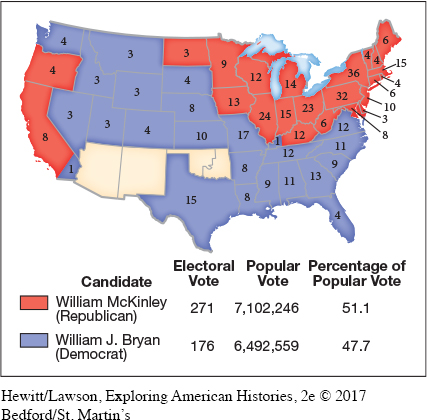Political Realignment in the Election of 1896
The presidential election of 1896 marked a turning point in the political history of the nation. Democrats nominated William Jennings Bryan of Nebraska, a farmers’ advocate who favored silver coinage. When he vowed that he would not see Republicans “crucify mankind on a cross of gold,” the Populists endorsed him as well.
Republicans nominated William McKinley, the governor of Ohio and a supporter of the gold standard and high tariffs on manufactured and other goods. McKinley’s campaign manager, Marcus Alonzo Hanna, an ally of Ohio senator John Sherman, raised an unprecedented amount of money, about $16 million, mainly from wealthy industrialists who feared that the free and unlimited coinage of silver would debase the U.S. currency. Hanna saturated the country with pamphlets, leaflets, and posters, many of them written in the native languages of immigrant groups. He also hired a platoon of speakers to fan out across the country denouncing Bryan’s free silver cause as financial madness. By contrast, Bryan raised about $1 million.
The outcome of the election transformed the Republicans into the majority party in the United States. McKinley won 51 percent of the popular vote and 61 percent of the electoral vote. More important than this specific contest, however, was that the election proved critical in realigning the two parties. Voting patterns shifted with the 1896 election, giving Republicans the edge in party affiliation among the electorate not only in this contest but also in presidential elections over the next three decades (Map 17.1).

What happened to produce this critical realignment in electoral power? The main ingredient was Republicans’ success in fashioning a coalition that included both corporate capitalists and their workers. Many urban dwellers and industrial workers took out their anger on Cleveland’s Democratic Party and Bryan as its standard-bearer for failing to end the depression. In addition, Bryan, who hailed from Nebraska and reflected small-town agricultural America and its values, could not win over the swelling numbers of urban immigrants who considered Bryan’s world alien to their experience.
The election of 1896 broke the political stalemate in the Age of Organization. The core of Republican backing came from industrial cities of the Northeast and Midwest. Republicans won support from their traditional constituencies of Union veterans, businessmen, and African Americans and added to it the votes of a large number of urban wageworkers. The campaign persuaded voters that the Democratic Party represented the party of depression and that Republicans stood for prosperity and progress. They were soon able to take credit for ending the depression when, in 1897, gold discoveries in Alaska helped increase the money supply and foreign crop failures raised American farm prices. Democrats managed to hold on to the South as their solitary political base.
Exploring American HistoriesPrinted Page 573
Exploring American Histories Value EditionPrinted Page 425
Chapter Timeline